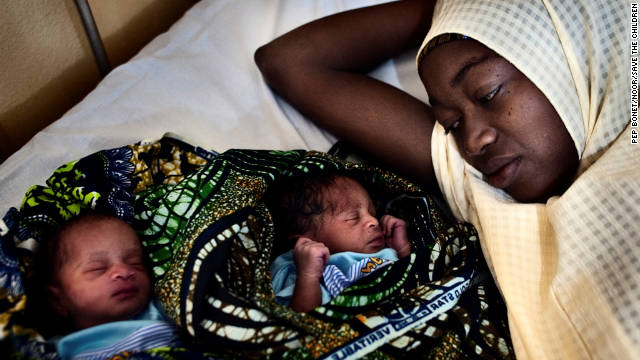
- The number of children a woman has increases her risks during her next pregnancy
- Too many pregnancies can deplete mother's nutrients and stretch her uterus
- Many in the developing world do not have access to contraception or maternal care
(CNN) -- In Niger, a woman gives birth to an average of nearly eight children. Countries like Uganda, Mali and Somalia are close behind, with an average of six to seven children per woman.
With every pregnancy and birth, a woman's risk of dying increases.
"There's a clear connection between countries that have a high fertility rate, where women are having six to seven children, and the maternal mortality rates," said Dr. Dorothy Shaw, a clinical professor in obstetrics and gynecology at the University of British Columbia in Canada.
Pregnancy and childbirth complications are among the leading causes of death among women living in developing countries, according to the World Health Organization. Each pregnancy magnifies the mother's health risks, especially when she doesn't have access to health care.
"We hear pregnancy is considered so natural and childbirth is considered a part of life, but there is a real sense of a complication and death," said Mary Beth Powers, Save the Children's chief of the Child Survival Campaign. "One out of seven women will face complication. That's a global figure."
Some experts believe that having pregnancies too close together doesn't give the mother time to recover after losing nutrients such as iron and folate after pregnancy and breastfeeding. This is called maternal depletion syndrome.

 Helping low-income women and babies
Helping low-income women and babies 
 Healthy diet and fewer birth defects
Healthy diet and fewer birth defects Back-to-back pregnancies can deplete essential nutrients, making mothers at higher risk for anemia and other complications such as uterine rupture, and also putting their babies at risk of low birth weight and preterm birth.
"Taking care of someone who has had a significant number of children, once you get past two to three children, the risks increase for complications like postpartum hemorrhage," Shaw said.
Family planning: Get the facts about pregnancy spacing
After numerous pregnancies, the uterus "is not as taut," said Shaw, who has visited clinics in Mozambique, Bangladesh and Tanzania. "So the more children you have, the more likely you have a significant complication. The chances of having the baby not lying in the right position when going into the labor, that's more common."
After several pregnancies, the uterine muscles could fail to contract after delivery, which is the most common cause of postpartum hemorrhage. This excessive blood loss can be stopped with medical attention and immediate treatment such as a blood transfusion. But in many countries, these resources are not available. There may not be hospital staff, or even infrastructure to transport patients safely to the hospitals. The families may be unable to pay for hospital fees
Ted Turner: 7 billion reasons to empower women
In some Indonesian hospitals, women cannot bring their babies home unless they pay for their hospital fees. Those who cannot pay may have to relinquish their parental rights and place their babies up for adoption, according to Robin Lim, a midwife who founded birthing clinics in Aceh and the island of Bali, in her native Indonesia.
Lim, who founded health clinics to offer free prenatal care, birthing services and medical aid, is one of the Top 10 CNN Heroes of 2011. Her work seeks to focus attention on the needs for maternal health resources.
On Monday, the world's population reached 7 billion. Women today are having half as many children as their mothers and grandmothers, wrote Fred Pearce, an environment journalist who studies population issues. The global average is now down to 2.5 children per woman, and it continues to fall, he wrote. Pearce: How women defused population bomb
In places like rural Africa, women still have have little control over their reproductive health, although they are well aware of the effects of numerous pregnancies. They also have multiple pregnancies because many of their children don't survive because of newborn complications and childhood diseases.
"They realize there's a toll on them, raising six to seven children, going through pregnancy six to seven times, often those times at home or in a clinic," said Powers. "They know they're at risk."
Every day, about a thousand women in the world die from causes related to pregnancy and childbirth, according to the World Health Organization.
The risk factors increase when women give birth when they're too young, too old, have too many or have pregnancies too close together.
In developing countries, common complications such as obstructed birth, preeclampsia (high blood pressure during pregnancy) or excessive bleeding can kill the mother, the child or both.
The WHO estimates that about 200 million couples in developing countries would like to delay or stop childbearing but do not use any method of contraception because of the lack of access, limited choices, fear and cultural or religious reasons.
"In poorer countries, we know women are not seeking to have large numbers of children," said Shaw, a former president of the International Federation of Gynecology and Obstetrics. "In many cases, they would like to limit family size. They don't have access to effective contraceptive that's affordable and acceptable and available to them."
The Chart: 5 best and worst places to be a mother
One of the most popular forms of birth control in developing countries is the hormone injection.
"Depo-Provera has become incredibly popular in many countries because husbands don't know their spouse is using contraceptives," said Powers. It eliminates the need to negotiate birth control with the sexual partner.
A woman who has two children spends about 30 years of her life trying to prevent pregnancies, Shaw said. Statistics show that contraceptives have become much more popular in recent years. WHO found that contraceptive use has increased globally from 54% in 1990 to 63% in 2007.
"When birth goes well and normally and has a good outcome, it's a beautiful experience," Shaw said. "Obviously, for the majority of women, that's what would happen, particularly in a well-nourished, educated population. Unfortunately, there are complications. ... We know globally, this (issue) is neglected."
No comments:
Post a Comment